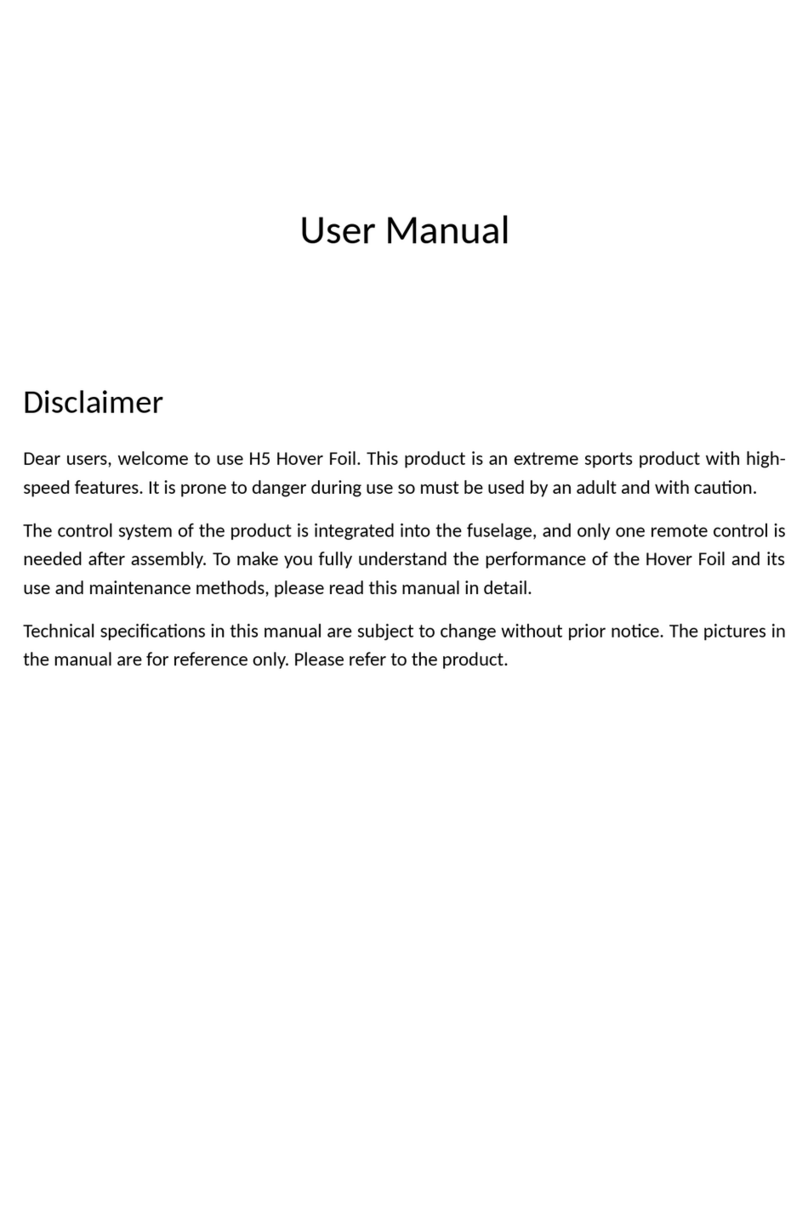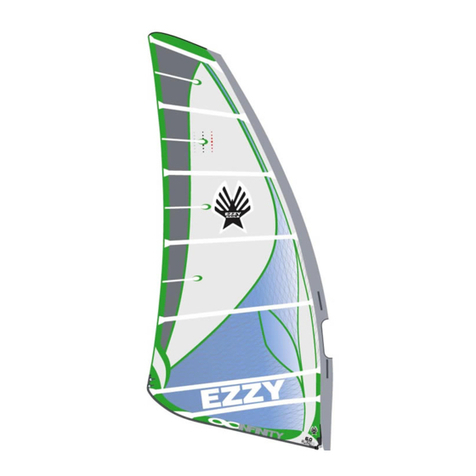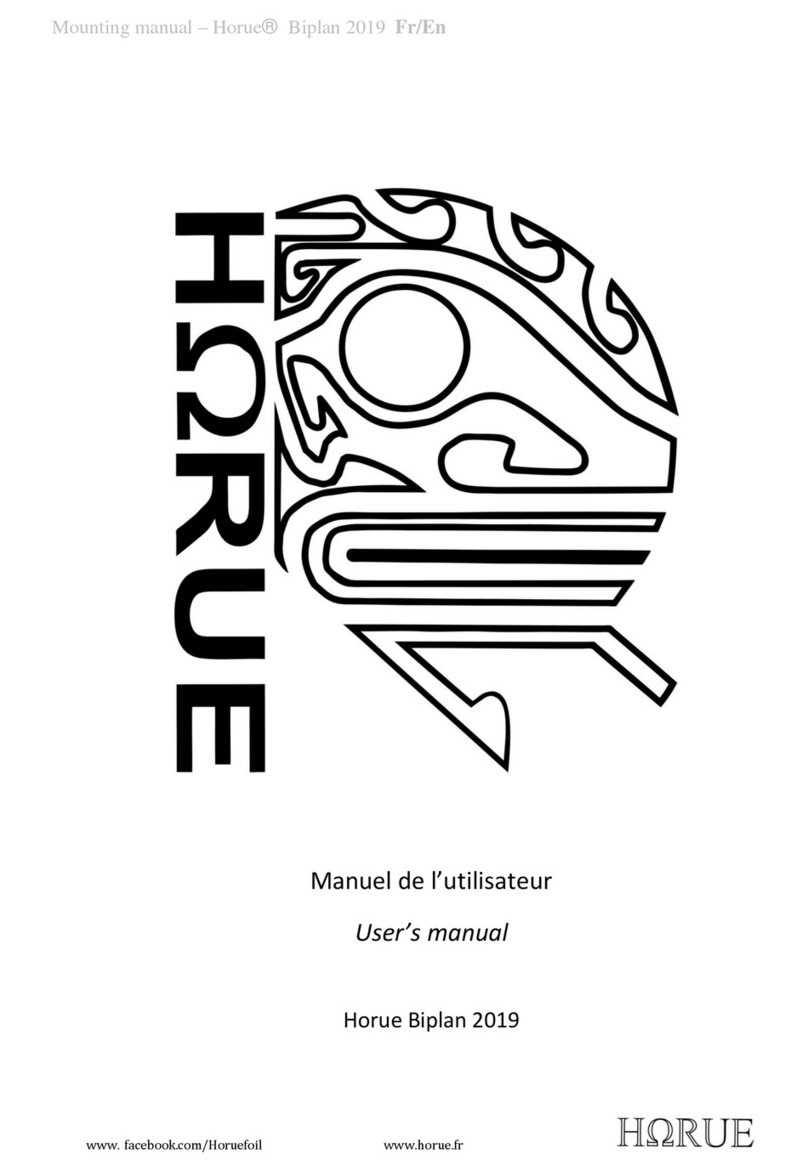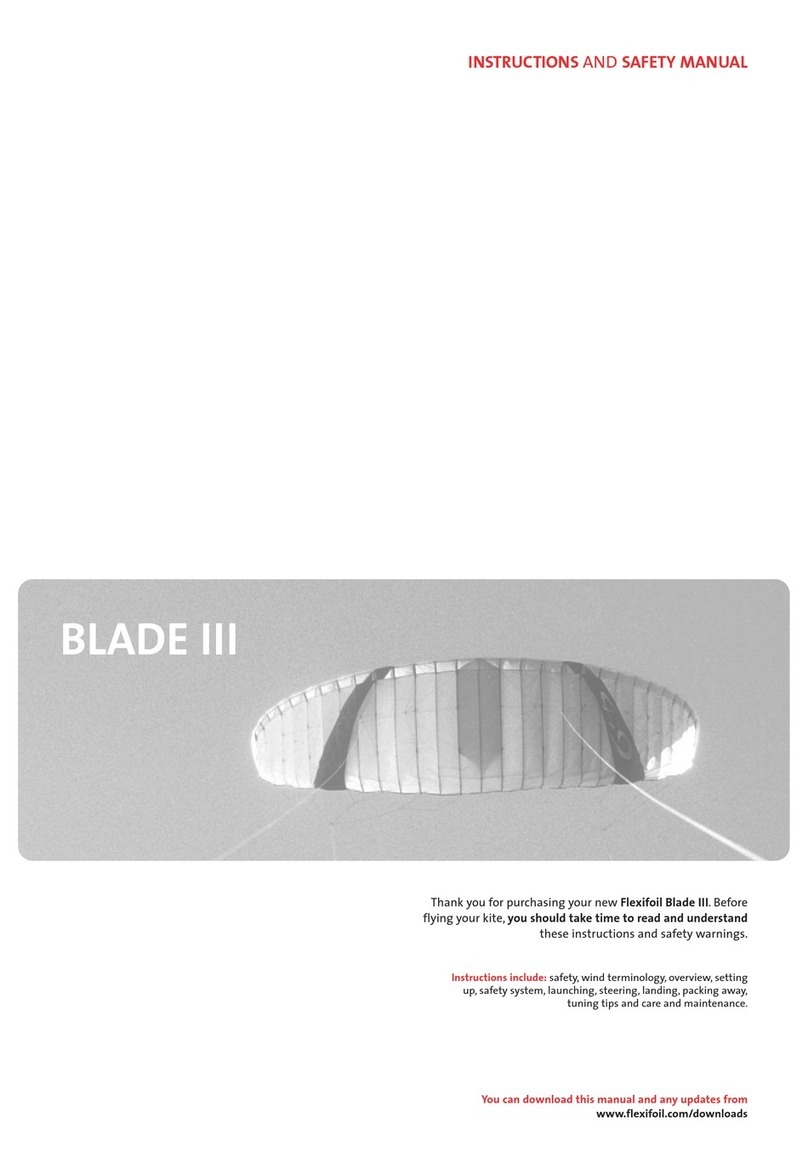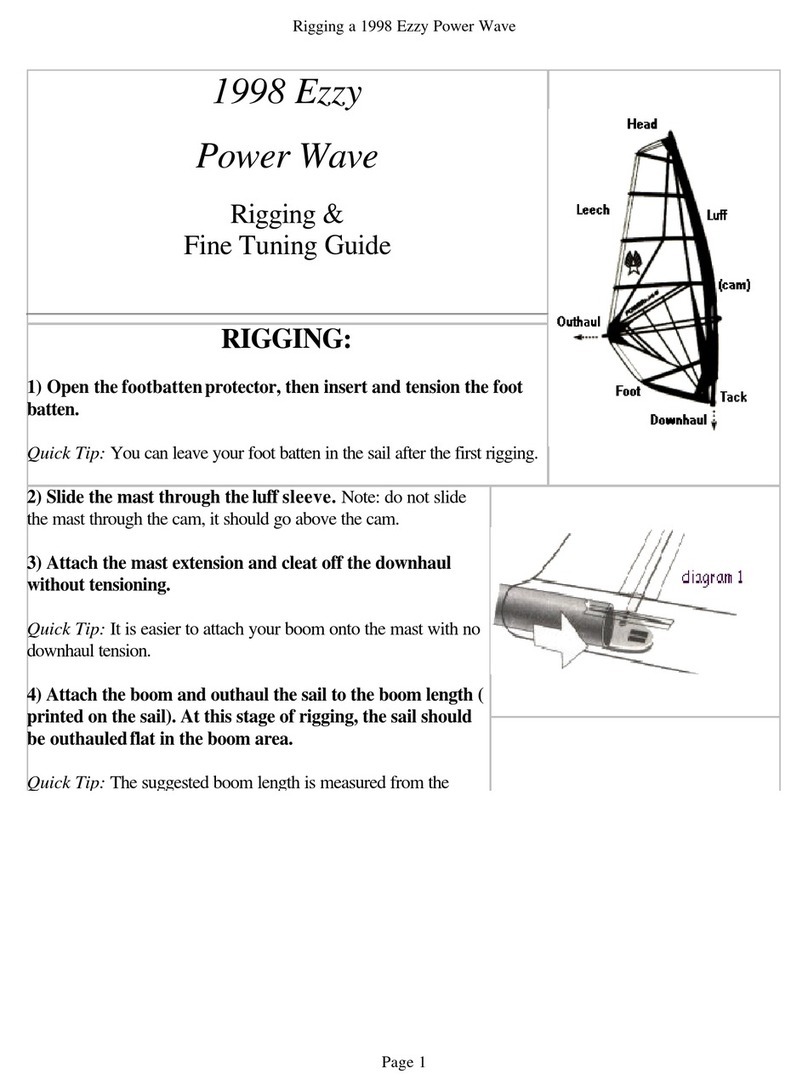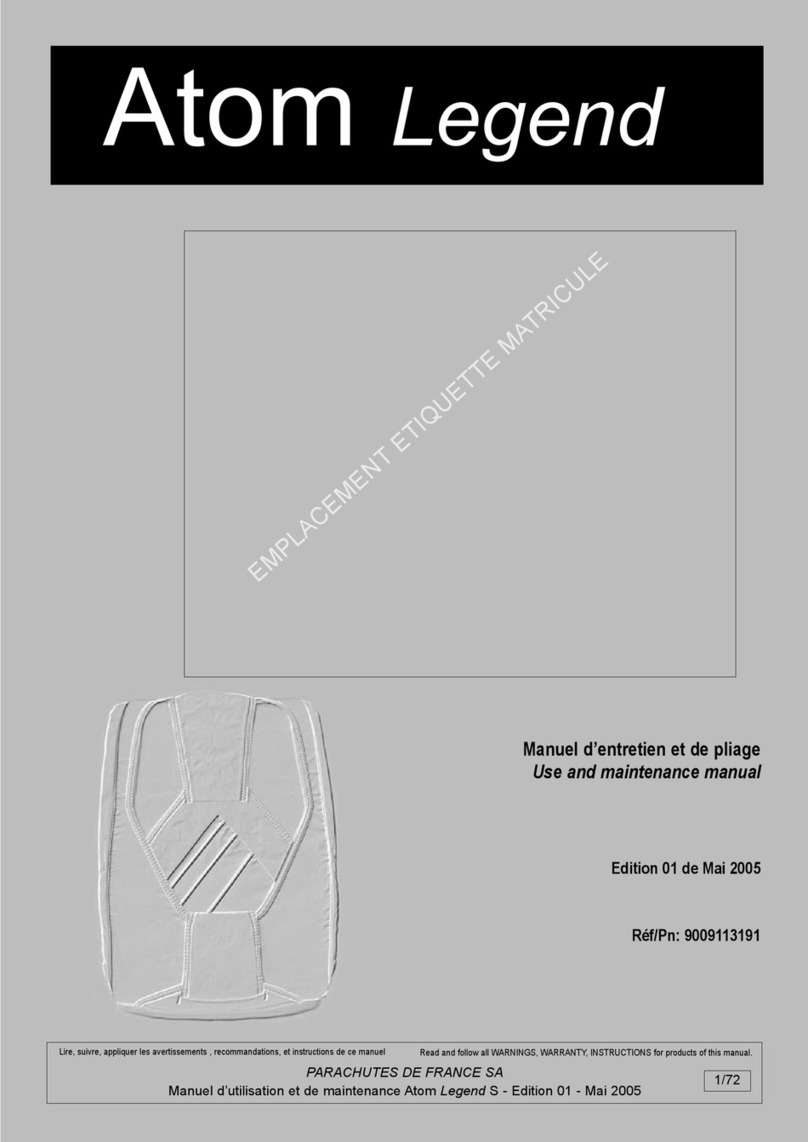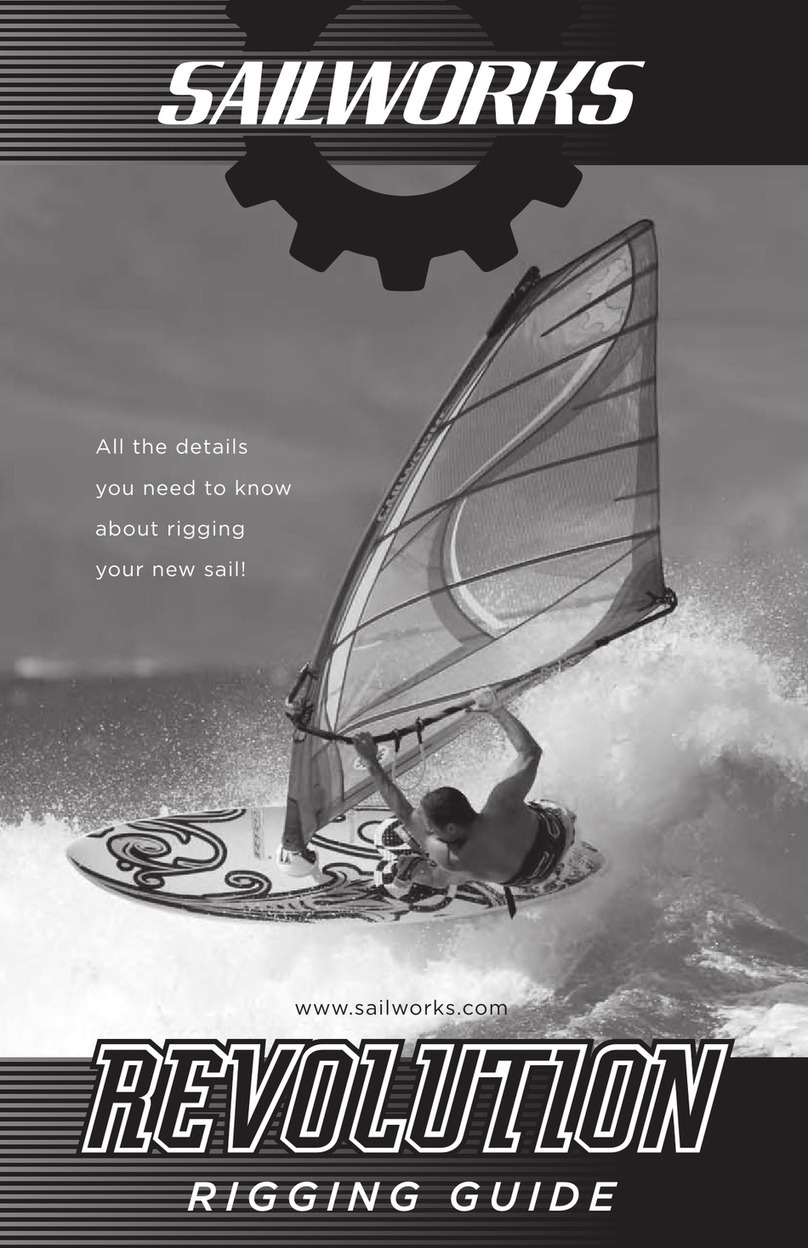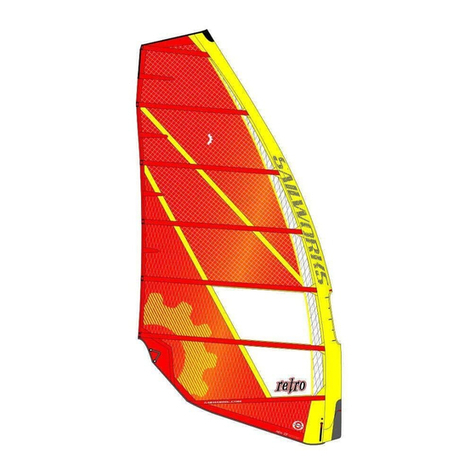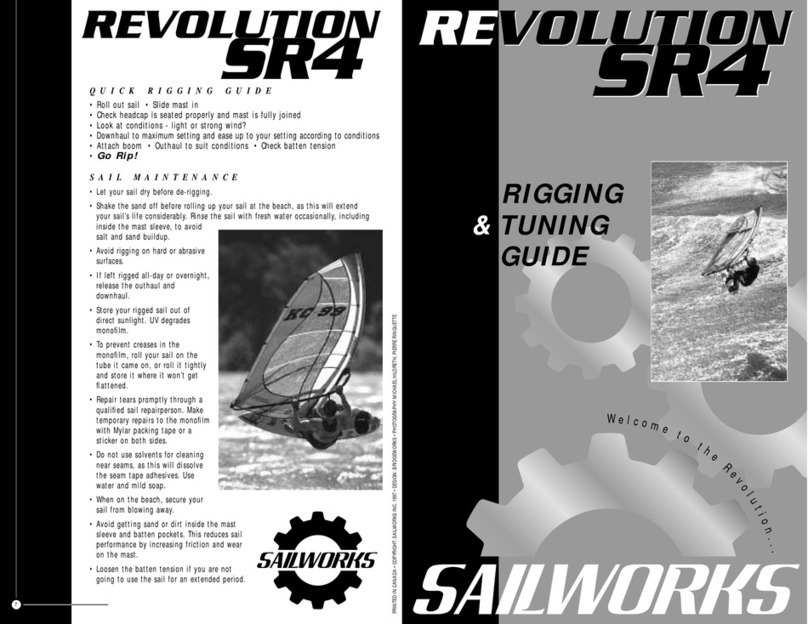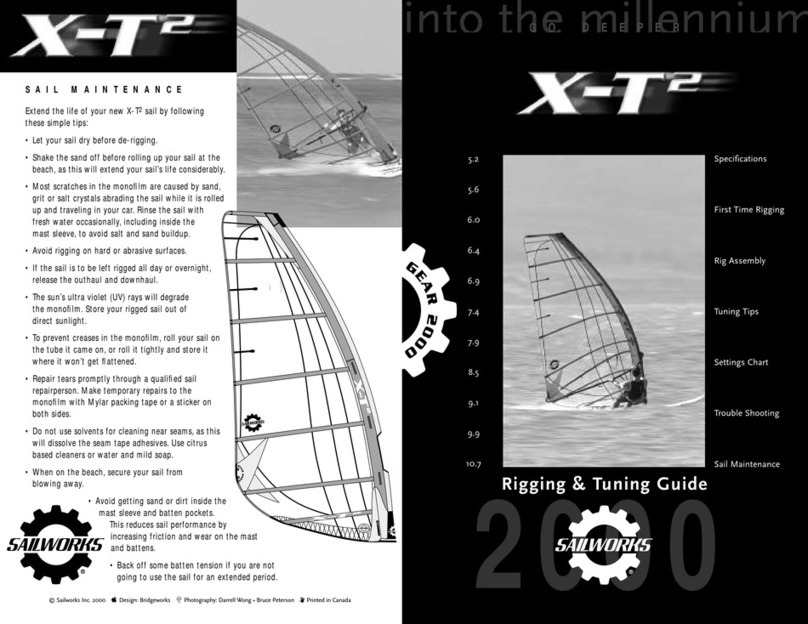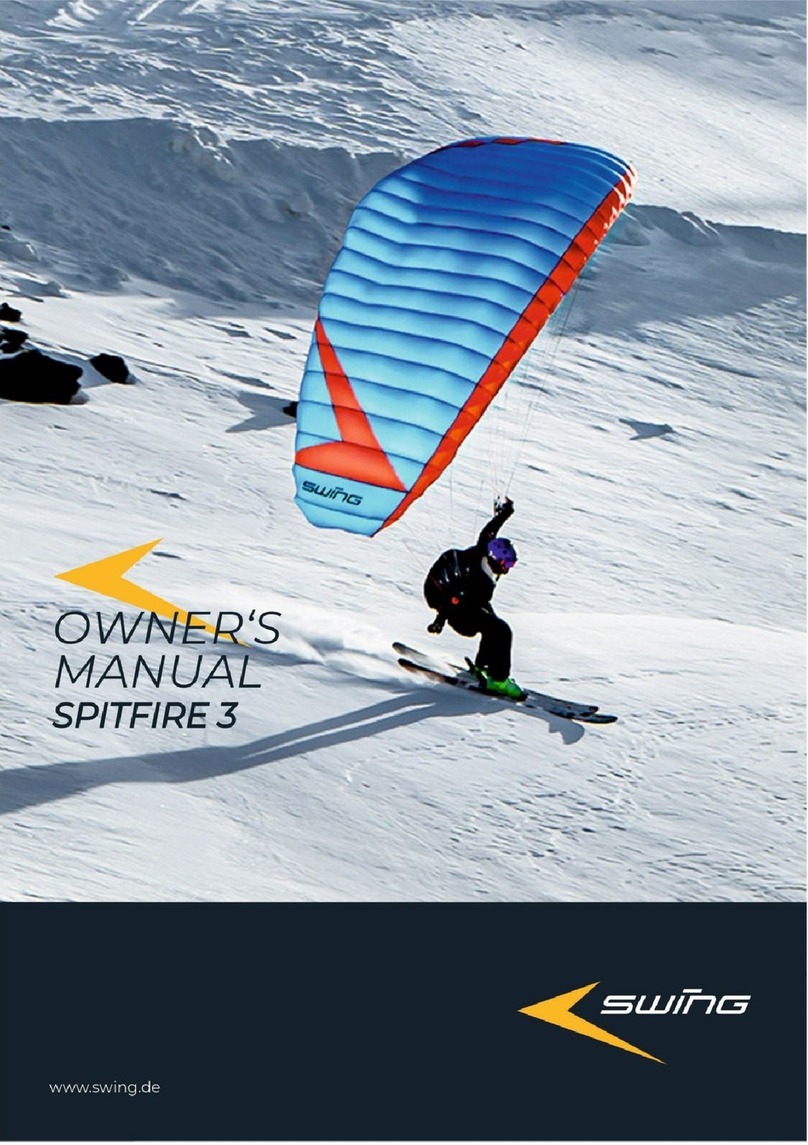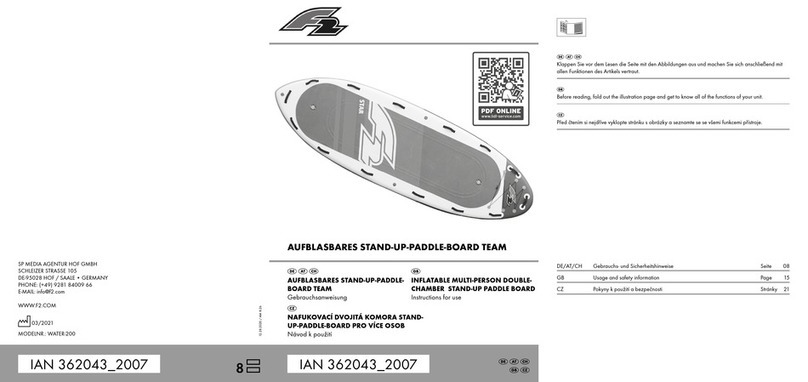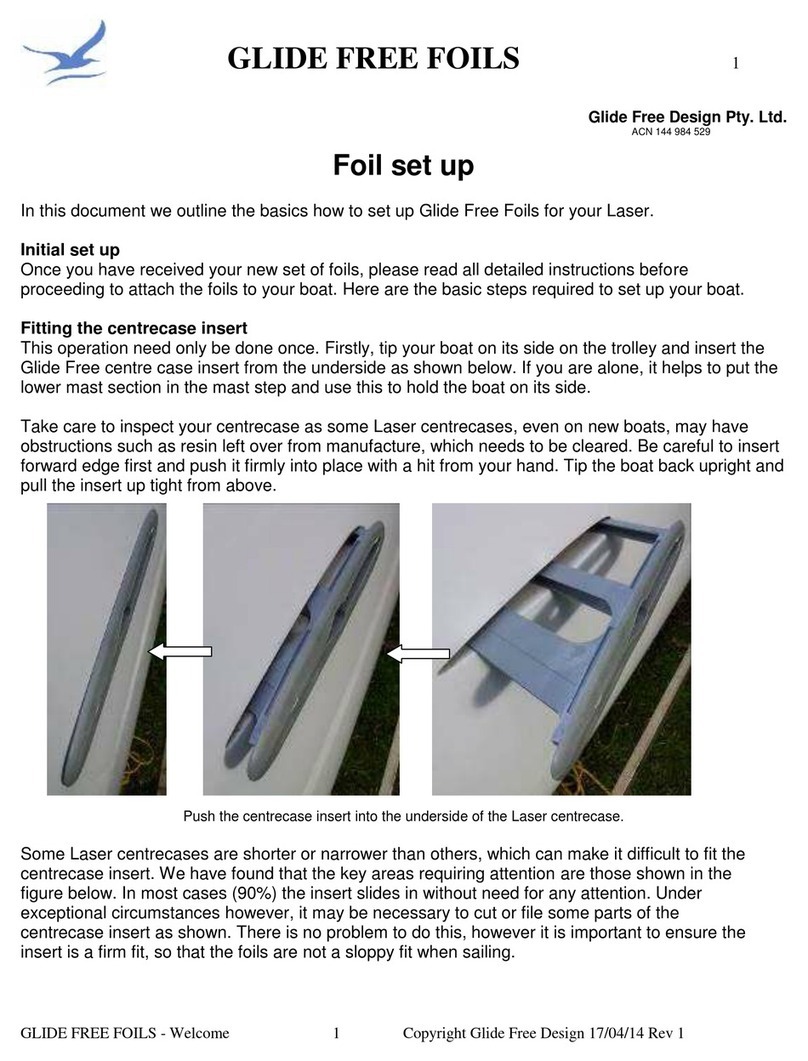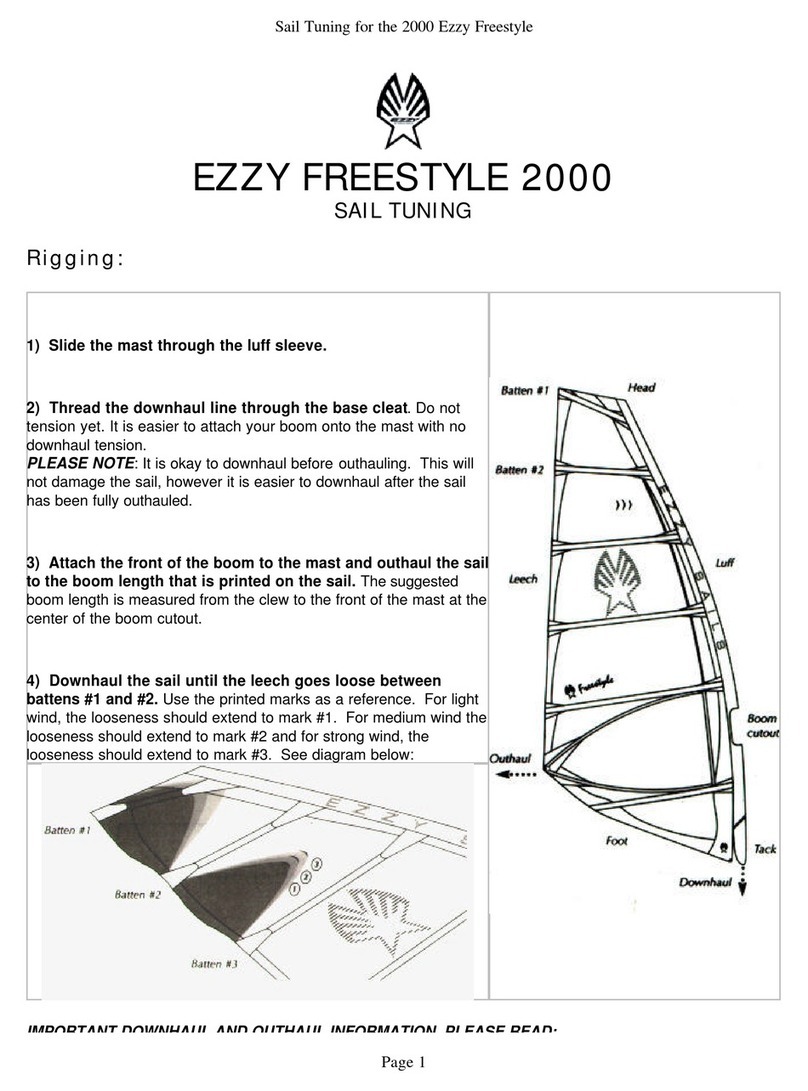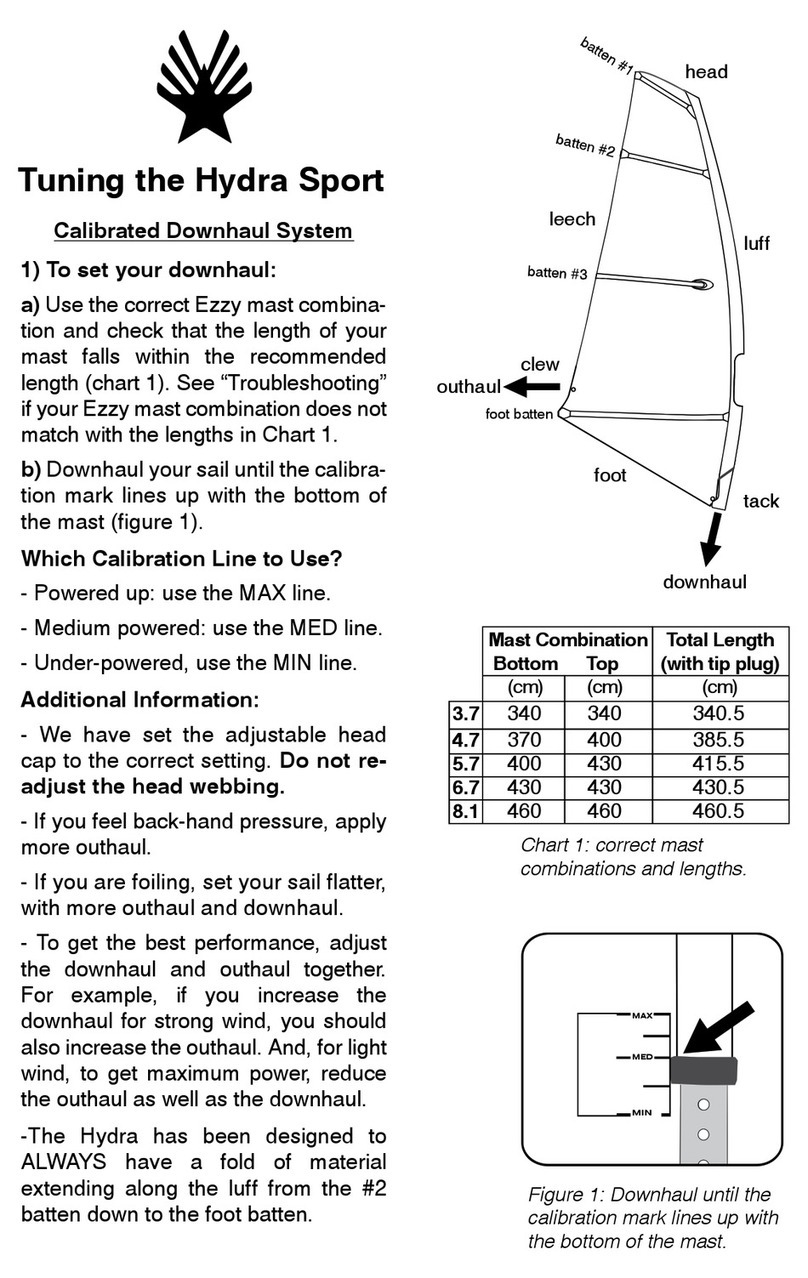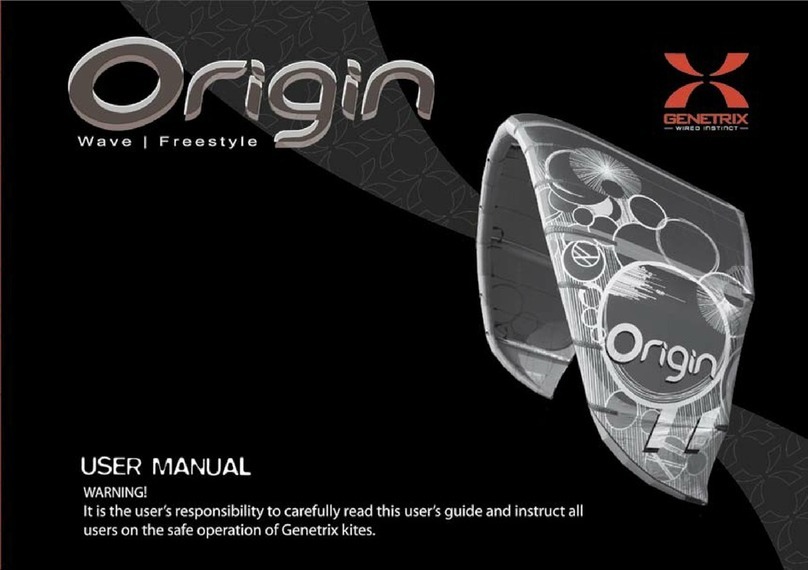Assembly & Rigging
3. ATTACH THE BOOM
The NX sails are designed to be used in onjun tion with an adjustable outhaul system. If you are not
urrently using an adjustable outhaul, Sailworks highly re ommends that you try the one supplied
with this sail.
Before atta hing the boom to the mast, follow the instru tions en losed with the adjustable outhaul
for setup and use. Adjust your boom to the length spe ified for the sail.
Atta h the boom to the mast at the middle of the boom opening and re-adjust it after the sail is fully
rigged. Be areful not to atta h it too high in the boom opening - you must a ount for the sail to be
downhauled further. Be areful not to pin h the mast sleeve under the boom lamp.
La e the outhaul through the lew grommet that mat hes your height preferen e. Pull the outhaul
ompletely so the sail is flat, using the re ommended boom length. This setting - loose downhaul and
tight outhaul - makes it very easy to put the ams ba k on the mast, and adjust the amber tension, if
ne essary.
4. ADJUST THE CAMBERS
Your new NX sail omes with Sailworks’ unique Variable Tension Camber
(VTC) system. This VTC system allows you to adjust the amber tension
separately from the batten tension, and also adapts the amber indu er to fit
a variety of mast diameters.
With the sail assembled as des ribed in steps 1-3
above (i.e. loose downhaul and tight outhaul),
open the zipper a ess port at ea h amber and
re-seat any ams that may have ome off the
mast: push down and ba k on the batten from above, while pushing up
and forward on the am from the underside of the sail. Next, pop open
the adjustment bu kle by pulling up on the webbing tail. The adjustment
bu kle “snap-fits” into the side of the am. To tension the am, pull the
webbing strap forward (toward the mast) while simultaneously pushing
the batten down and ba k from the mast – see photo. As you push
down on the batten, work the sla k webbing free by pulling the strap
forward and ba k a few times. Rotate the am from side to side with
your hand to equalize the strap tension within the amber. The webbing
strap inside the am is held very snugly so it may take more than one
attempt to pull out all the sla k.
The orre t VTC setting should tension the
mast sleeve snugly without impeding rotation.
Set the ams tight against the mast for optimal
ontrol and upwind drive. Set the ams slightly
looser for easier rotation and better handling
for slalom rea hing.
Snap the adjustment bu kle firmly ba k into
the side of the am. It should sit flush with the
side of the am when losed. If the ams are
set very tight, and the zipper is diffi ult to
lose, wait until the sail is fully downhauled
before trying to lose the zippers. If the zipper
is still diffi ult to lose, you’ve set the ams too
tight. Release some amber tension by opening
the adjustment bu kle and rotating the amber
on e. On e the am tension is set, you don’t
need to re-adjust it for ea h session!
5. TUNE THE DOWNHAUL - CONTROLLING THE SHAPE AND TWIST
(Refer also to the tuning hart on the following pages.)
The downhaul ontrols the sail’s shape, twist and wind range performan e. Dis over its effe t
by slowly pulling and releasing the downhaul line. If ne essary, use an easy-rig or downhauling
tool so it is easier to pull hard. Observe the hange in depth and tension of the leading edge
(front 1/3 of the sail), and the flattening and loosening of the head area (upper lee h between
batten #2 & #3) as more downhaul is pulled. Spe ifi ally noti e the hange in the angles, or
twist, of the battens; the top batten should open to leeward the furthest— alled “progressive
twist. The twist profile is ut into the sail, but is ultimately ontrolled by the downhaul tension.
More downhaul indu es more twist; less downhaul allows less twist. Twist improves sail
effi ien y and makes the sail easier to ontrol when fully powered. Less twist is more powerful
for light winds, but more diffi ult to ontrol when fully powered.
The ideal downhaul setting gives a tight luff and a lean (not blunt) entry, with the lee h area
between the ends of the top three battens loose. The stati looseness to the lee h is normal
and will pull tight as the sail twists open under wind load. See the photos on the next page for
spe ifi visual referen es to downhaul tension and lee h looseness. On e you’re familiar with
the orre t downhaul setting, re- he k the mast base height. If ne essary, re-adjust it so that
the ta k pulley sits very lose to the mast base leat and the sail is rigged as low as possible.
6. TENSION THE STREAMLINED BATTEN TENSIONERS (SBT’s)
The battens are tensioned
using the hex-key tool
found under the strap in
the ta k handle. Insert the
hex-key into the ap s rew
inside the SBT at the lee h
end of ea h batten. Turn
the hex-key to the right
( lo kwise) to in rease
batten tension. Tension the
battens JUST until the wrinkles a ross the batten po kets
disappear. Look for a ontinuous smooth shape to the
sail loth alongside the batten po ket (see photos). You
should see a smooth refle tion, with no wrinkles alongside
the battens. Repla e the hex-key tool ba k in its po ket
above the ta k handle. The batten tension will need to be
re-tightened after one or two uses as the sail sets into its
final shape, but then it need not be readjusted for every
session!
CAUTION: DO NOT OVER-TENSION THE BATTENS
–POOR ROTATION, E CESSIVE FOIL DEPTH AND
DAMAGE TO THE SAIL CAN RESULT.
7. BALANCE THE OUTHAUL SETTING
Release any outhaul tension and allow the sail to relax naturally to its fullest depth. Pull just
enough outhaul tension to pull the sail up off the boom tube and tighten the lew area. This is
a good all-around outhaul setting. If ne essary, re-adjust the ba k end of your boom to just
tou h the lew of the sail and tie off the outhaul. If you are using the adjustable outhaul system
you need to set your boom length slightly longer to allow for the outhaul to be pulled flatter.
From a neutral setting, slightly less outhaul (negative) will make the sail fuller and more
powerful for rea hing, but it will also be harder to ontrol when over-powered or sailing upwind.
For upwind sailing or over-powered onditions, a small amount of outhaul tension (positive
4-5 m, or 2”) will improve performan e by making the sail flatter and tighter.
To save time rigging next session, take note or mark off the position of su essful
downhaul and outhaul settings so they are easy to qui kly repeat next session.
See the Sailworks website – www.sailworks. om - for more rigging information and
frequently asked questions.
Needs more batten tension
Correct batten tension
